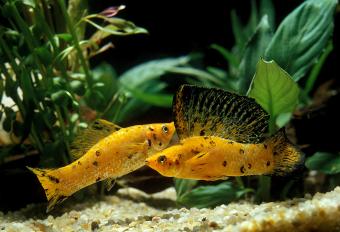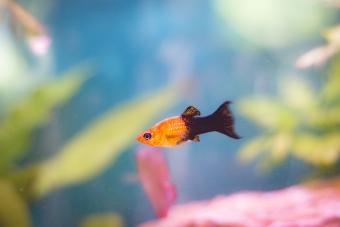
We hear congratulations are in order. Your guppy is expecting fry! These easy-to-care-for and fun-to-watch fish are great to have in your tank, but be warned. One pregnant guppy fish can quickly overstock a tank—hence the nickname, "The Million Fish." If you have one pregnant guppy, you might soon feel like you've got a million. Learn how to identify a pregnant guppy and care for her and her fry.
How to Tell if a Guppy Is Pregnant
The easiest way to tell if a guppy is pregnant is to look for a dark spot under her tail toward the backside of the stomach. This dark spot is called a gravid patch. As the babies grow, this guppy gravid spot will increase in size while also becoming darker. In the final stages of pregnancy, the spot will become black, and the guppy will look very bloated or fat.
Your guppy will show other signs of pregnancy, too.
- The fish's coloring will fade.
- The gills will remain partly opened.
- The fish will have an arched back and will appear to be pushing.
- The fish's eating habits will change, either eating voraciously or not at all.
- The guppy will remain in or around one spot in the aquarium, often around the heater.
- The guppy may become more aggressive or skittish.
- The stomach of the fish may take on an almost square appearance.
Remember to be gentle and avoid stressing your pregnant guppy during this exciting time.
Caring for a Pregnant Guppy
The guppy pregnancy stages progress quickly, as the gestation period is typically less than a month. Proper care is essential for your pregnant guppy.
Feeding
A pregnant guppy needs good nutrition to sustain herself as well as her developing fry. Unfortunately, just like how many of us feel when we're pregnant, she's not able to eat very much at a time due to the space the fry take up. So it's important to feed three to five small meals throughout the day so you don't overload her. Just give her a small pinch so there's not a lot of leftover food to foul the tank. It's a good idea to offer her live or frozen brine shrimp daily along with a high-quality flake food, some spirulina flakes, and even some freeze-dried bloodworms.
Delivery Time
Experts recommend that you remove a pregnant guppy from the community tank or isolate her in a part of it so she can give birth to her fry. Actually, you should prepare two separation tanks—the one the fry will remain in after they are birthed, and a second tank you can move mom into so she can recover for a couple days following delivery before she returns to the community tank.
Having a tank solely for the fry ensures that the mom or other fish in the community tank won't eat them, and it makes it easier to care for them during the first few weeks of development. As soon as you notice that one of your guppies is pregnant, you have about a month to get ready for the birth. Prep should start as soon as you find out.
If you're anticipating the birth and it doesn't occur within 24 hours of the mother being placed in isolation, return her to the community tank. Keeping a pregnant fish in isolation for more than two days can inhibit the maturation of the fry. If you return the fish to the tank, try turning the heat up slightly in the aquarium to help the maturation process of the fry, and then watch for signs she is getting ready to give birth.
If so, gently move her to the isolation tank once again. After she gives birth, slowly return the water temperature to normal. Watching an actual birth on video will really help you understand what to expect.
Isolate After Birth
After the birthing is done, keep her in isolation for a minimum of 24 to 48 hours to recover. It's also important to feed her well during this period since she will be very hungry after giving birth.
Guppies Having Babies: Length of Average Delivery
In most normal circumstances, the guppy birthing process takes between two and six hours, but if the mother is having difficulty, it can take up to 12 hours for all the fry to be delivered. In some cases, the mother will deliver a few fry and then stop the delivery only to resume in a few days.
Caring for the Fry
After the fry are born, it's important to feed them often. Many experts agree that feeding them as many as five times a day is good practice, since the first four weeks of life are when they go through their greatest growth. When the fry are fed well, they are ultimately healthier, hardier fish. Due to their tiny size, the fry require extremely small food. This can include pulverized flakes and freshly hatched brine shrimp.
Guppy Population Control
Guppy fry develop their gender at the four-week mark, and they become sexually active at the six-week mark, so it is important to separate the males from the females between these two points to prevent them from breeding. We know it doesn't give you much time to get materials together, so finding the things you'll need before your guppies become sexually active can be incredibly helpful.
In order to tell the males from the females, take each fry out of the tank individually and place them in a clear container. Use a magnifying glass to determine if the fish has a gravid spot; if it does, place them in the female tank. Eventually, the fry mature, and you can sell them or give them away.
The Miracle of (Guppy) Life
Guppies require a certain amount of care to ensure their good health, and a pregnant guppy requires a little extra care so that she and her fry fare well throughout pregnancy, birth, and beyond. Follow the care info outlined here, and you'll be off to a great start.







